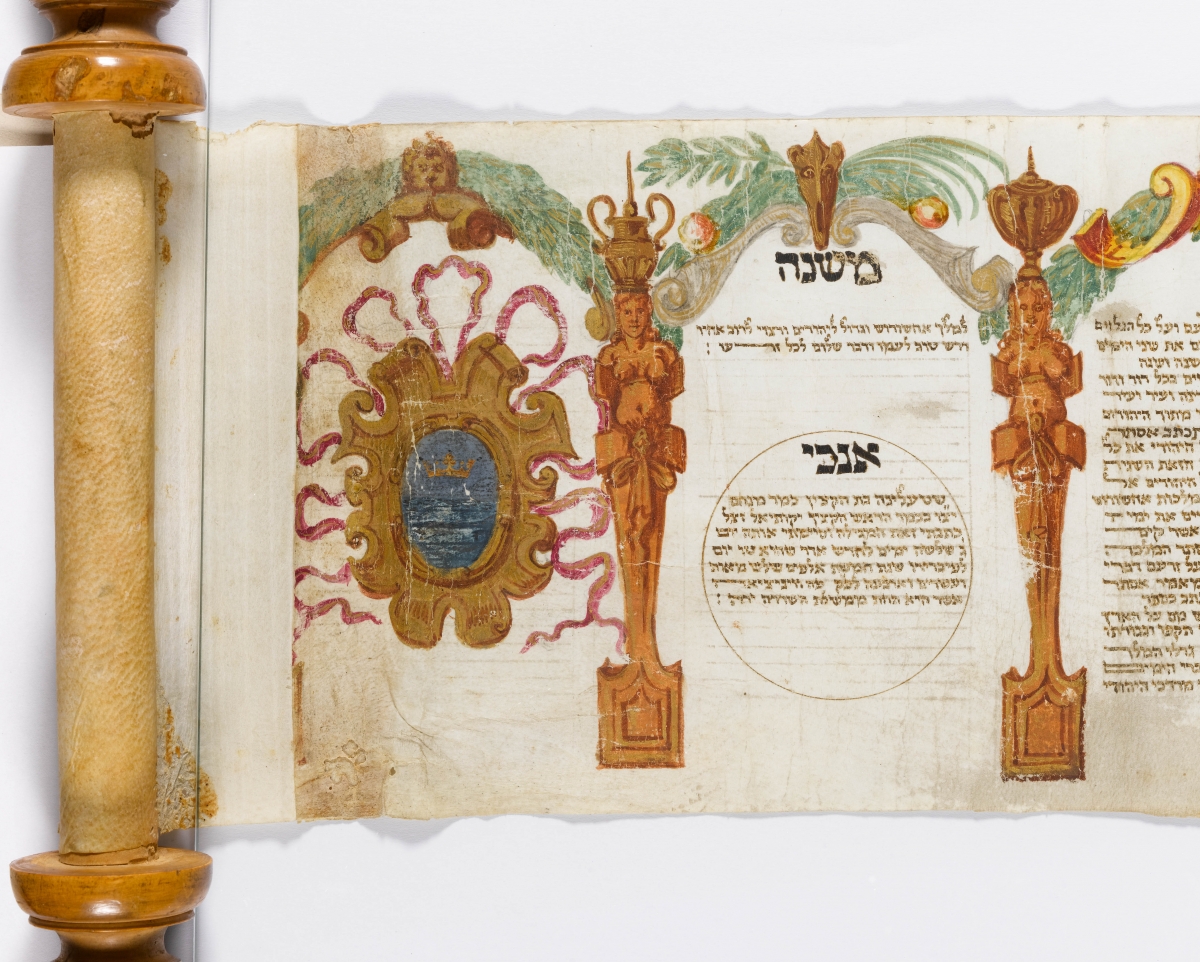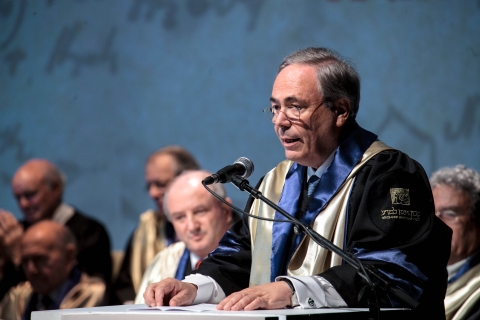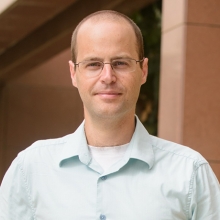Sculpting science
René and Susanne Braginsky are facilitating the fusion of science and the humanities
People behind the science

If there is a signature motif of the Braginsky family philanthropy, it is an effort to preserve the narrative thread of Jewish and Israeli heritage. So how does the Weizmann Institute fit into that “story”?
“The Weizmann Institute is a continuation of that thread which must be preserved and strengthened, because , who with his wife Susanne established the Braginsky Center for the Interface between Science and the Humanities at the Weizmann Institute in 2010. Five years later, the Center is a thriving hub of research with an unusual twist for the Weizmann Institute: the integration of the humanities and the arts into science.
Its director, Prof. Itamar Procaccia, a member of the Department of Chemical Physics, is an art collector himself. To date, the Center has funded nearly 30 projects. Among its first projects was the Theatre Lab intiated by Prof. Uri Alon of the Department of Molecular Cell Biology, which brings together scientists and performing artists to explore themes in human interaction; one project, on coordinated motion, may lead to an intervention tool for adults with autism spectrum disorders.
“The Center is a unique vehicle that enables the support of highly innovative projects which would otherwise not be funded by standard granting agencies,” says Prof. Procaccia. “This may promise unprecedented insights and shed light on often overlooked areas in research that involve the nexus of humanities and science.”
René and Susanne Braginksy live in Zurich and split their time between Switzerland and Israel. Their son David and his family live in Tel Aviv. René, a banker who runs his own boutique office in Zurich, is a past president of Keren Hayesod, and he and Susanne are major supporters of the Israel Museum and other institutions in Israel and Switzerland, including ETH Zurich.
The Braginskys’ relationship with the Weizmann Institute originated in his friendship with Maurice Dwek, former chairman of the European Committee of the Weizmann Institute of Science and an International and Executive Board member who passed away in 2013. René was president of the Society of Swiss Friends of the Weizmann Institute of Science from 1999 to 2009, and received an honorary doctorate from the Institute in 2012. As president of the Society of Swiss Friends, he says he “witnessed the passion… with which students and researchers from all over the world approached scientific challenges. It is this belief in the future and this great drive which characterize the Weizmann Institute of Science.”
As president, he started an annual lecture series that continues to bring Weizmann Institute scientists to Switzerland in a forum that typically involved a Swiss scientist and one from the Weizmann Institute. During that period, he substantially expanded the Institute’s network of friends and supporters in Switzerland.
After stepping down from the role, the Braginskys made a gift to establish the Braginsky Center for the Interface between Science and the Humanities. Its agenda “fits perfectly with our commitment to the arts, humanities, and history and at the same time serves to advance science at the Weizmann Institute in a creative, inspiring direction,” says René.
The couple’s commitment to preserving the Jewish narrative is rooted in their family history. René’s father was orphaned at age 16 and survived World War II in Switzerland. “It is only today that my brother and I have the privilege of leading peaceful and secure lives,” he says. “We are profoundly grateful for this.” The family’s geographical trajectory over time - moving from Eastern Europe to Western Europe, and children moving to Israel in the last decades - “explains our cultural and charitable activities in Israel,” he adds.

Susanne is the former publisher of Aufbau, a German-Jewish magazine published in New York, a role she took on, she says, to preserve this special piece of Jewish history. She is independently involved in many philanthropic activities that also align with the themes her husband holds dear.
In line with their belief that Jewish communities worldwide should promote Jewish history and heritage, the couple established the Braginsky Foundation 30 years ago, which supports numerous projects that do just that, including exhibitions and museum.
One of René’s biggest passions is his collection of Jewish manuscripts, known as the Braginsky Collection. It includes more than 80 medieval Hebrew manuscripts, the largest compilation of 18th Century haggadot [Passover Seder books] and prayer books, and a unique private collection of megillot [scrolls] and ketubot [marriage certificates]. The collection, which is kept in Zurich, has been exhibited in Amsterdam, New York, Jerusalem, Zurich, and Berlin.
In 2009, on the occasion of his 60th birthday, he published A Journey through Jewish Worlds: Highlights from the Braginsky Collection of Hebrew Manuscripts and Printed Books, which describes his love for this art form and its role in preserving the historical narrative of the Jewish people. The collection has been digitized and a sampling is viewable on his website (www.braginskycollection. ch) and on iPad apps. A new English website is currently under construction.
René has always been a collector: Before Jewish manuscripts, it was stamps and coins, paintings, and books. As an entrepreneur and investor, he says, “I find that many people seem to believe that financial and economic crises are unique phenomena. We tend to overestimate current problems and often find it difficult to put them into their proper historical perspective. This realization leads to the key notion of my activities as a collector, that without knowing the past, we can hardly come to terms with the present and much less prepare for the future.”
His manuscript collection started when their son, David, who is 36, had his bar mitzvah. “I started to look for a bentsher [prayer booklet of blessings after meals] for that occasion, but I couldn’t find a really beautiful one in time and had to make do with a copy.” He talked to a good friend, an expert in Jewish manuscripts, and he began collecting; 25 years later this private hobby came to be known as the Braginsky Collection.
“The manuscripts provide me with a direct connection to my Jewish past,” says René. “It is comforting that in today’s hectic world, one can return to these centuryold objects and realize that what is really important will stay.”
Perfect fusion: A sampling of programs funded
by the Braginsky Center
Does art therapy really work?
Individuals suffering from stress, anxiety, depression, and other symptoms of serious and chronic diseases such as cancer, Alzheimer’s, and schizophrenia often turn to art therapy for relief. But art and other expressive arts-based therapeutic interventions are not founded on clinical experiments and physiological reasoning as drug therapies are. Prof. David Harel and Dr. Bilha Sandak of the Department of Computer Science and Applied Mathematic s are developing a computational paradigm for showing, with empirical precision, if and how complex dynamic behavioral processes work in the expressive arts—visual, music, and dance—with the goal of applying it to patients, and in other real-world settings.
Do genes and language share evolutionary patterns?
Both genes and languages evolve. What can we learn about the evolution process of each to apply to the other? In this project, spearheaded by Prof. Yitzhak Pilpel of the Department of Molecular Genetics and Prof. Ghil’ad Zuckermann of the University of Adelaide, a linguistics expert, principles in computational genomics are being applied to the evolution of the Hebrew language; and vice versa. The duo has been able to quantify major dynamic trends of language change, such as the takeover of Biblical and Talmudic terms by neologisms, the transfer and acclimation into the language of foreign words, and grammatical and stylistic changes—for example, the four-fold shortening of sentences over the last century. And just as written neologism of today become tomorrow’s lexicon—like “drive through” becoming “drive thru”—they have been able to show that RNA and DNA “mimicking” changes occur, generating new breeds of genes created under certain conditions.
How does coordinated behavior emerge?
Think regatt a racers: How do the athletes attain near-perfect unison in their rowing movements? Dr. Itai Cohen of Cornell University is exploring how collective behavior arises in animals that form flocks, herds, and swarms; and how humans can coordinate in similar ways—like when a regatta team races for the finish line or a couple dances the tango. The study of movement in animals and humans—called biolocomotion—offers rich data sets for study. Dr. Cohen and his colleagues are now trying to discern what cues affect the ability to achieve and maintain synchronous movement.

René and Susanne Braginsky

René Braginsky receiving his honorary PhD from the Weizmann Institute in 2012







